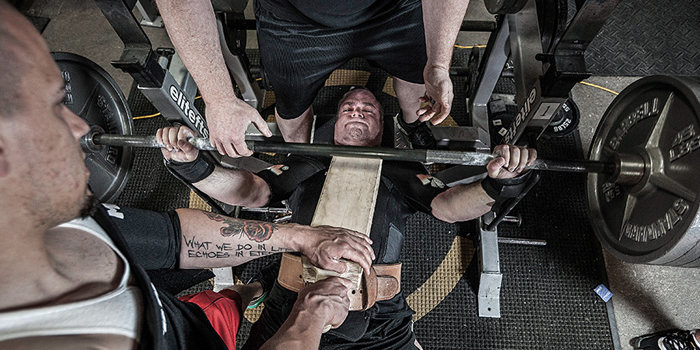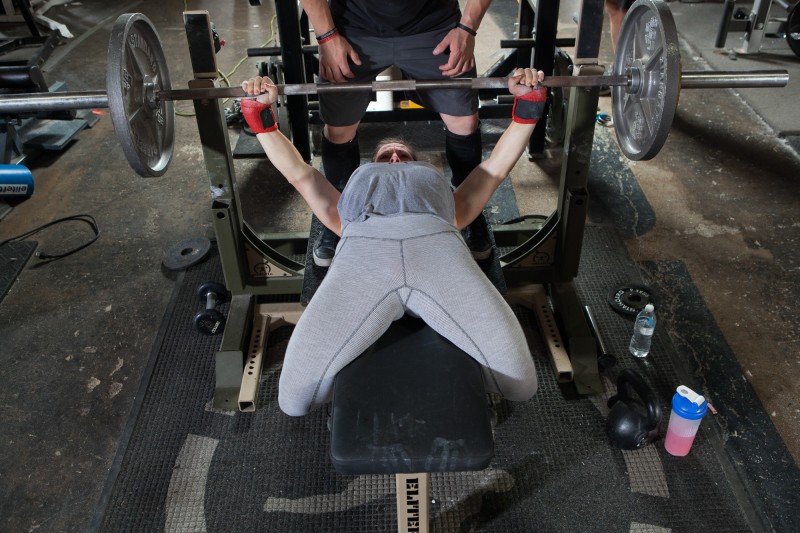
If we have been around long enough in powerlifting, we probably have seen those gear benchers training heavy with up to five 1.5-foot wooden boards. If that were the case, what followed for sure was wondering if that could be useful in some way for you, a raw lifter.
Well, what I will try to do here is show some scientific evidence that supports the fact that it could be indeed a good idea, or at least, we should give it a try, especially under some circumstances.
LISTEN: Table Talk Podcast Clip — Jim Wendler's 5 Core Values for Training
Although it’s a type of training that has gained attention in the last few years, this type of training is not new at all; it is what Zatsiorsky, the world-renowned strength consultant for hundreds of elite Soviet athletes, called accentuation. The objective was to train heavy in the range where the main demand of high force was needed and was based on the thought that it is not necessary to train the maximal strength in the full range of motion (ROM) (1). Additionally, there were some other studies back in that time period showing short reps’ benefits (2–4).
Let us see in more detail what evidence has been reported concerning partial reps in each competition exercise.
Squat
The squat is a compound exercise for the lower body used to strengthen the hip and knee extensors muscles. It’s the first competition movement in the sport of powerlifting, in which the lifter is required to bend the knees and lower the body until the top surface of the legs at the hip joint is lower than the top of the knees (5).
It was observed in a study using surface electromyography that a partial back squat maximizes the activation levels of the gluteus maximus, biceps femoris, and erectors spinae when compared to the full back squat of men training the execution of 10RM. On the other hand, both partial and full squats demonstrated a similar level of muscle activation of the quadriceps femoris (6).
A similar case was observed in a study in which recreational lifters trained for seven weeks, either with a full ROM or a full ROM with partial ROM squats. The findings here suggest that when combined, the training of partial with full reps could be more effective than training only full ROM. This also supports the utilization of partial squat reps as an effective means of providing variation in a training program for experienced lifters (7).
In this case, if we need to accumulate work volume, training with full reps is the best option, because when compared with partial ROM, half of the sets will be needed to ensure a sufficient total work is performed (8).

Bench Press
Following the squat is the flat bench press, the second competition exercise of powerlifting and the only lift for the Paralympic powerlifting. It is a compound exercise with acceleration and deceleration phases with the last one near the sticking point region, at which the movement is likely to fail (9,10). Moreover, that is the main reason equipped benchers train with the wooden boards: they need to strengthen and complete the lift (lock out the elbows), especially at the point where the extra elastic force given by the bench shirt starts decreasing.
However, not everything is so clear. A study from 2004 compared the full versus partial ROM in the bench press of recreational lifters, even though the three groups showed increased strength after the 10-week training period, there were no differences between groups. It should be noted that the training sessions consisted of three sets by 15 reps twice a week (11).
In another study (12) conducted with young men without lifting experience, the results showed that after the two days a week for 10 weeks of training time, the full ROM training was superior to the partial one. They trained in the 20-8 range rep by two to four, respectively. The exercise used here was a bilateral preacher curl.
It was also observed in another study that in elbow flexion exercises, the full ROM induces greater muscle damage when compared with the partial one (13).
Deadlift
In the last competition movement in powerlifting, lifters are able to choose to deadlift in either sumo or conventional style. Actually, there is a lack of evidence about this exercise since most research has been done on the squat and the bench press. There is a single study involving partial deadlifts, which analyzed the kinematics of partial and conventional deadlifts. The EMG results showed that the partial exhibited significantly greater knee flexion and less hip extension. Regarding the leverages, it was found that full range deadlift had a significantly smaller average thorax angle in the lockout compared to the partial. No significant differences were found in average or peak muscular activation between either variation (14).
Take-home Messages
What authors argued is that the use of full reps for the inexperienced lifter is way more convenient. Full reps help them better learn proper technique and improve strength and muscle gains; in addition, the full ROM execution may lead to less psychological and bone joint stress (12).
It seems that this kind of training could be useful especially for more experienced athletes when combined with full ROM lifts (3,7,11,12). Because during the early stages of training, the initial increases in strength are due to the coordinated activation of both the involved and stabilizing muscles (15).
Furthermore, partial reps may constitute a good tool when advanced lifters reach a plateau. One of the advantages of partial lifting is that we can overcome the main full ROM training limitation: the deceleration toward the end of the movement (16), and the other one is the possibility to work with supramaximal loads in the area of the ROM where maximal force is produced (3).
References
- Zatsiorsky VM, Kraemer WJ. Science and practice of strength training [Internet]. Human Kinetics; 2006 [cited 2018 Sep 23]. 251 p. Available from: https://books.google.cl/books/about/Science_and_Practice_of_Strength_Trainin.html?id=QWSn4iKgNo8C&printsec=frontcover&source=kp_read_button&redir_esc=y#v=onepage&q&f=false
- Graves JE, Pollock ML, Jones AE, Colvin AB, Leggett SH. Specificity of limited range of motion variable resistance training. Med Sci Sports Exerc [Internet]. 1989 Feb [cited 2018 Oct 14];21(1):84–9. Available from: http://www.ncbi.nlm.nih.gov/pubmed/2927306
- Mookerjee S, Ratamess N. Comparison of Strength Differences and Joint Action Durations Between Full and Partial Range-of-Motion Bench Press Exercise [Internet]. Vol. 13, National Strength & Conditioning Association J. Strength and Cond. Res. 1999 [cited 2018 Oct 14]. Available from: http://0492355529c28b373e63-88d50621e0f8da6d50792584fec156ec.r36.cf5.rackcdn.com/mookerjee-ratamess-1999-Isolated-joint-activation.pdf
- Sullivan JJ, Knowlton RG, DeVita P, Brown DD. Cardiovascular Response to Restricted Range of Motion Resistance Exercise. J Strength Cond Res [Internet]. 1996;10(1). Available from: https://journals.lww.com/nsca-jscr/Fulltext/1996/02000/Cardiovascular_Response_to_Restricted_Range_of.1.aspx
- International Powerlifting Federation. Technical Rules book of the IPF [Internet]. 2016 [cited 2018 Sep 23]. Available from: https://www.powerlifting-ipf.com/fileadmin/ipf/data/rules/technical-rules/english/IPF_Technical_Rules_Book_2016__1_.pdf
- da Silva JJ, Schoenfeld BJ, Marchetti PN, Pecoraro SL, Greve JMD, Marchetti PH. Muscle Activation Differs Between Partial and Full Back Squat Exercise With External Load Equated. J Strength Cond Res [Internet]. 2017 Jun [cited 2018 Oct 15];31(6):1688–93. Available from: http://insights.ovid.com/crossref?an=00124278-201706000-00029
- Bazyler CD, Sato K, Wassinger CA, Lamont HS, Stone MH. The Efficacy of Incorporating Partial Squats in Maximal Strength Training. J Strength Cond Res [Internet]. 2014 Nov [cited 2018 Oct 15];28(11):3024–32. Available from: https://insights.ovid.com/crossref?an=00124278-201411000-00002
- Drinkwater EJ, Moore NR, Bird SP. Effects of Changing from Full Range of Motion to Partial Range of Motion on Squat Kinetics. J Strength Cond Res [Internet]. 2012 Apr [cited 2018 Oct 15];26(4):890–6. Available from: http://www.ncbi.nlm.nih.gov/pubmed/22222322
- Clark RA, Humphries B, Hohmann E, Bryant AL. The Influence of Variable Range of Motion Training on Neuromuscular Performance and Control of External Loads. J Strength Cond Res [Internet]. 2011 Mar [cited 2018 Oct 14];25(3):704–11. Available from: http://www.ncbi.nlm.nih.gov/pubmed/20581702
- Elliott BC, Wilson GJ, Kerr GK. A biomechanical analysis of the sticking region in the bench press. Med Sci Sports Exerc [Internet]. 1989 Aug [cited 2018 Oct 14];21(4):450–62. Available from: http://www.ncbi.nlm.nih.gov/pubmed/2779404
- Massey CD, Vincent J, Maneval M, Moore M, Johnson JT. An Analysis of Full Range of Motion vs. Partial Range of Motion Training in the Development of Strength in Untrained Men. J Strength Cond Res [Internet]. 2004 Aug [cited 2018 Oct 14];18(3):518. Available from: http://www.ncbi.nlm.nih.gov/pubmed/15320644
- Pinto RS, Gomes N, Radaelli R, Botton CE, Brown LE, Bottaro M. Effect of Range of Motion on Muscle Strength and Thickness. J Strength Cond Res [Internet]. 2012 Aug [cited 2018 Oct 14];26(8):2140–5. Available from: http://www.ncbi.nlm.nih.gov/pubmed/22027847
- Baroni BM, Pompermayer MG, Cini A, Peruzzolo AS, Radaelli R, Brusco CM, et al. Full Range of Motion Induces Greater Muscle Damage Than Partial Range of Motion in Elbow Flexion Exercise With Free Weights. J Strength Cond Res [Internet]. 2017 Aug [cited 2018 Oct 14];31(8):2223–30. Available from: http://www.ncbi.nlm.nih.gov/pubmed/27398917
- Beeler MK, Inglis SD, Ammon R, Kraemer WJ, Comstock BA. A Kinematic And Kinetic Analysis Of The Partial And Conventional Deadlift In Resistance-trained Males. Med Sci Sport Exerc [Internet]. 2017 May [cited 2018 Oct 15];49:390. Available from: http://https//insights.ovid.com/crossref?an=00005768-201705001-01142
- Rutherford OM, Jones DA. The role of learning and coordination in strength training. Eur J Appl Physiol Occup Physiol [Internet]. 1986 [cited 2018 Oct 17];55(1):100–5. Available from: http://www.ncbi.nlm.nih.gov/pubmed/3698983
- Clark RA, Bryant AL, Humphries B. An Examination of Strength and Concentric Work Ratios During Variable Range of Motion Training. J Strength Cond Res [Internet]. 2008 Sep [cited 2018 Oct 14];22(5):1716–9. Available from: http://www.ncbi.nlm.nih.gov/pubmed/18714211
Exal García-Carrillo is currently living in Chile, where he is finishing an MSc in Sports Sciences and has been in competitive powerlifting since 2011. He can be reached for coaching inquiries at exal.garcia@gmail.com.










